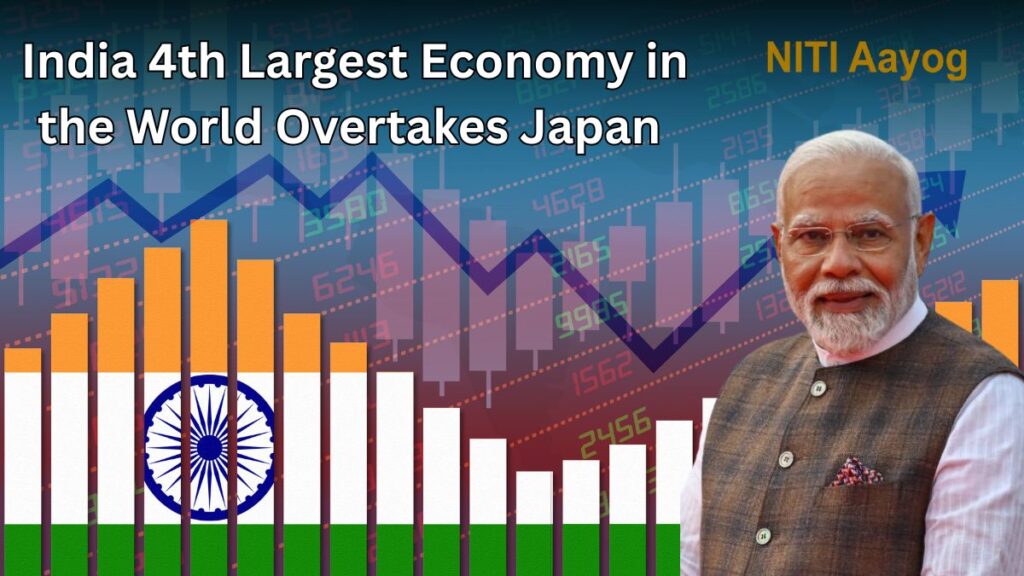India 4th Largest Economy in 2025 with a $4.39 trillion GDP, surpassing Japan. Discover the growth drivers, reforms, and what’s next for India’s economic future, India now ranks just behind the United States, China, and Germany. This major achievement reflects the country’s rapid economic growth, strong government reforms, and a young, energetic workforce.
India’s journey from a developing economy to a global power is a story of vision, innovation, and resilience. This article explains how India got here, what’s driving its economy, the challenges it faces, and the road ahead toward its “Viksit Bharat 2047” vision.
India 4th Largest Economy Growth Journey
Economic Reforms That Changed Everything
India’s transformation started in 1991, when major economic reforms opened the market to global trade and investment. GDP growth jumped from 4% in the 1980s to 6% in the 1990s. More recent changes like the Goods and Services Tax (GST) in 2017 and corporate tax cuts in 2019 further boosted business and economic competitiveness.
- GDP Growth: From $1 trillion in 2007 to $4.39 trillion in 2025
- Reform keywords: Liberalization, GST, corporate tax cuts
High-Performing Sectors
- Services Sector (55% of GDP): IT, finance, tourism
- IT industry worth $250 billion
- Employs over 5.4 million professionals
- Tourism: Earned $35 billion in 2024
- Manufacturing (17% of GDP): Driven by the Make in India campaign
- Apple, Tesla, and Samsung have set up manufacturing hubs
- Agriculture (15% of GDP): Supports 42% of workforce
- Government schemes like PM-KISAN have increased farmer incomes
Key Economic Numbers
- India’s GDP: $4.39 trillion (2025)
- Projected GDP: $5.5 trillion by 2028
- Top Economies:
- United States – $28.7 trillion
- China – $18.3 trillion
- Germany – $4.5 trillion
- India – $4.39 trillion
- Annual GDP Growth: Averaged 8.2% over the last decade, projected 6.8% for 2025
What’s Leads India to become 4th largest economy in the world?
Strong Government Policies
Key economic initiatives and reforms are transforming India:
- Viksit Bharat 2047: Vision to become a developed nation by 2047
- NITI Aayog: Led by CEO BVR Subrahmanyam, pushing digital and inclusive growth
- PLI Scheme: Attracted $20 billion in manufacturing investments
- Infrastructure Spend: Over $130 billion in 2024
Demographic Power
- Median age: 28 years
- 600 million+ workers (20% of global working-age population)
- Middle class: Expected to be 50% of population by 2030
- Consumer spending: Hit $2.5 trillion in 2024
Foreign Investment and Trade
- FDI in 2024: $85 billion (20% growth from 2023)
- Exports: Reached $450 billion — led by IT, pharma, and textiles
- Global partnerships: Stronger ties with the US, EU, and Indo-Pacific nations
Impact of “Make in India”
Boost to Manufacturing
Launched in 2014, the Make in India campaign:
- Attracted $100 billion+ in investments
- Created over 10 million jobs
- Made India a global smartphone manufacturing hub
- 70% of Indian-made phones are now exported
Innovation and Startups
- 100,000+ startups supported by Startup India
- Digital economy worth $200 billion in 2024, heading to $1 trillion by 2030
- Key hubs: Bengaluru, Hyderabad (home to 500+ R&D centers)
- Leading in AI, 5G, green tech
- Solar capacity: 85 GW — 3rd largest in the world
Regional Growth
- Growth spreading to Tier 2 and Tier 3 cities like Ahmedabad, Coimbatore
- Backed by National Infrastructure Pipeline ($1.4 trillion by 2030)
- Big push in highways, high-speed rail, and 5G networks
Key Challenges Ahead
Income Inequality
- Top 1% own 40% of wealth
- Rural-urban gap remains wide
- Need for targeted support in eastern and underdeveloped regions
Job Creation and Skills
- Unemployment rate: 6.5% (2024)
- Skill India has trained 50 million people since 2015
- Still a big gap in skills for AI, green energy, and tech sectors
Environmental Sustainability
- Coal powers 70% of energy needs — causing high pollution
- India aims for net-zero emissions by 2070
- Needs faster transition to renewable energy and eco-friendly cities
What’s Next: India by 2030 and Viksit Bharat 2047
Economic Outlook
- GDP forecast: $5.5 trillion by 2028, possibly overtaking Germany
- IMF growth estimate: 6.5% annually through 2030
- Focus areas: semiconductors, green hydrogen, infrastructure
Policy Goals
- Digital inclusion for all
- Doubling renewable energy capacity
- High-speed rail expansion
- Global trade integration with the US, EU, and ASEAN
Global Influence
India is becoming a key global player. Strategic diplomacy, tech leadership, and trade growth enhance India’s status — but success depends on solving domestic inequalities and maintaining political stability.
Frequently Asked Questions
What does it mean for India to be the 4th largest economy in 2025?
It means India has overtaken Japan with a $4.39 trillion GDP, showcasing its global economic power.
How did “Make in India” help the economy?
It brought in $100 billion+ investments, boosted manufacturing, and created millions of jobs.
Who is the NITI Aayog CEO and what do they do?
BVR Subrahmanyam leads India’s key economic planning body, shaping growth strategies.
What is “Viksit Bharat 2047”?
A national vision to make India a developed country by 2047, focusing on innovation, infrastructure, and sustainability.
How does this growth impact Indians?
More jobs, better living standards, and stronger global pride and influence.
What are the biggest hurdles?
Income inequality, unemployment, and environmental pollution.
Can India really reach $30 trillion GDP by 2047?
Yes, if current policies continue and global conditions remain favorable.
Conclusion
India’s climb to the 4th largest economy in 2025 marks a proud milestone. Fueled by strong reforms, demographic strength, and forward-thinking policies like Make in India and Viksit Bharat 2047, the country is poised for even greater success. With focused efforts to overcome challenges like inequality and pollution, India is on track to become a $5.5 trillion economy by 2028 and potentially a $30 trillion powerhouse by 2047.

